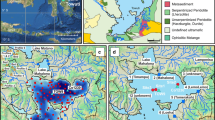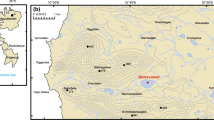Abstract
As part of a broader investigation into recent environmental change on Svalbard, the inorganic geochemical record of six lake-sediment cores was analysed. The major temporal trends in sediment elemental composition are driven by variations in two contrasting sediment components, both derived from catchment soils: (1) mineral matter, and (2) soil organic matter (SOM), enriched in Fe and Mn oxides and heavy metals. Two environmental impacts are recorded in most or all of the lake sediment sequences. An up-core increase in organic matter can be partly attributed to diagenetic effects, but also requires an enhanced supply of SOM relative to mineral matter. In addition, the central and southern sites all show a ca. 1970 event characterised by an enhanced mineral matter accumulation rate. This requires either an enhanced allochthonous supply or an enhanced mobilisation of littoral sediments. In either case a regional-scale driving force, such as a shift in climate, is required. At five of the lakes the sediment heavy metal concentration profiles can be explained entirely by natural factors. However, at Tenndammen (U), situated close to the Svalbard’s largest settlement at Longyearbyen, possible anthropogenic Pb enrichment is found. Comparison of observed and expected heavy metal profiles (based on Greenland ice-core data) shows that the lakes are generally too insensitive to have recorded a long-transported heavy metal pollution signal.
Similar content being viewed by others
References
Appleby P.G. 1997. Sediment records of fallout radionuclides and their application to studies of sediment-water interactions. Wat. Air Soil Pollut. 99: 573–586.
Appleby P.G. 2004. Environmental change and atmospheric contamination on Svalbard: sediment chronology. J. Paleolim. (this issue).
Appleby P.G., Nolan P.J., Gifford D.W., Godfrey M.J., Oldfield F., Anderson N.J. and Battarbee R.W. 1986. 210Pb dating by low background gamma counting. Hydrobiology 141: 21–27.
Bindler R., Renberg I., Anderson N.J., Appleby P.G., Emteryd O. and Boyle J.F. 2001. Pb isotope ratios of lake sediments in West Greenland: inferences on pollution sources. Atmos. Environ. 35: 4675–4685.
Birks H.J.B., Monteith D.T., Rose N.L., Jones V.J. and Peglar S.M. 2004. Recent environmental change and atmospheric contamination on Svalbard as recorded in lake sediments — modern limnology, vegetation and pollen deposition. J. Paleolim. (this issue).
Boutron C.F., Candelone J.P. and Hong S.M. 1995. Greenland snow and ice cores — unique archives of large-scale pollution of the troposphere of the northern-hemisphere by lead and other heavymetals. Sci. Tot. Environ. 161: 233–241.
Boyle J.F. 2000. Rapid elemental analysis of sediment samples by isotope source XRF. J. Paleolim. 23: 213–221.
Boyle J.F. 2001a. Geochemical methods in palaeolimnology. In: Smol J.P. and Last W.M. (eds), Tracking Environmental Change Using Lake Sediments, vol. 2: Physical and Chemical Techniques. Kluwer Academic Publishers, Dordrecht, pp. 83–141.
Boyle J.F. 2001b. Redox remobilization of heavy metals in lake sediments: a modelling approach. J Paleolim. 26: 423–431.
Boyle J.F. and Birks H.J.B. 1999. Predicting heavy metal concentrations in the surface sediments of Norwegian headwater lakes from atmospheric deposition: an application of a simple sedimentwater partitioning model. Wat. Air Soil Pollut. 114: 27–51.
Boyle J.F., Mackay A.W., Rose N.L., Flower R.J. and Appleby P.G. 1998. Sediment heavy metal record in Lake Baikal: natural and anthropogenic sources. J. Paleolim. 2: 35–150.
Brooks S.J. and Birks H.J.B. 2004. The dynamics of Chironomidae (Insecta: Diptera) assemblages in response to environmental change during the past 700 years on Svalbard. J. Paleolim. (this issue).
Cornwell J.C. 1986. Diagenetic trace-metal profiles in Arctic lake sediments. Environ. Sci. Technol. 20: 299–303.
Crecelius E.A. and Piper D.Z. 1973. Particulate lead contamination recorded in sedimentary cores from Lake Washington, Seattle. Environ. Sci. Technol. 7: 1053–1055.
Davison W. 1993. Iron and manganese in lakes. Earth Sci. Rev. 34: 119–163.
Deer W.A., Howie R.A. and Zussman J. 1966. An introduction to the rock-forming minerals. Longman, Harlow, pp. 528.
Engstrom D.R. and Wright Jr H.E. 1984. Chemical stratigraphy of lake sediments as a record of environmental change. In: Haworth E.Y. and Lund J.W.G. (eds), Lake sediments and environmental history, Leicester University Press, Leicester, pp. 11–68.
Fortin, D., Leppard G.G. and Tessier A. 1993. Characteristics of lacustrine diagenetic iron oxyhydroxides. Geochim. Cosmochim. Acta 57: 4391–4404.
Førland E.J., Hanssen-Bauer I. and Nordli P.Ø. 1997. Climate statistics and long-term series of temperature and precipitation at Svalbard and Jan Mayen. Det Norske Meteorologiske Institutt Rapport, 21/97 Klima, 72 pp.
Granina L.Z., Karabanov E.B. and Callender E. 1993. Relics of oxidized ferromanganese formations in the bottom sediments of Lake Baikal. IPPCCE News Lett. 7: 32–39.
Glew J.R. 1989. A new trigger mechanism for sediment samplers. J. Paleolim. 2: 241–243.
Hamilton-Taylor. J. 1979. Enrichments of zinc, lead and copper in recent sediments of Windermere, England. Environ. Sci. Technol. 13: 693–697.
Hilton J., Davison W. and Ochsenbein U. 1985. A mathematical model for analysis of sediment core data: implications for enrichment factor calculations and trace metal transport mechanisms. Chem. Geol. 48: 281–291.
Hjelle A. and Lauritzen Ø. 1982. Geological map of Svalbard 1:500 000, Skrifter Nr. 154c, Norsk Polar Institutt, Oslo.
Holte B., Dahl S., Gulliksen B. and Næs K. 1996. Some macrofaunal effects of local pollution and glacier-induced sedimentation, with indicative chemical analyses, in the sediments of two Arctic fjords. Polar Biol. 16: 549–557.
Hong S.M., Candelone J.P., Soutif M. and Boutron C.F. 1996. A reconstruction of changes in copper production and copper emissions to the atmosphere during the past 7000 years. Sci. Tot. Environ. 188: 183–193.
Jones V.J. and Birks H.J.B. 2004. Lake-sediment records of recent environmental change on Svalbard: results of diatom analysis. J. Paleolim. (this issue).
Krauskopf K.B. 1982. Introduction to Geochemistry. 2nd edition, McGraw-Hill, Singapore, 617 pp.
Mackereth F.J.H. 1966. Some chemical observations on post-glacial lake sediments. Phil. Trans. R. Soc. Lond. B250: 165–213.
Morfett K., Davison W. and Hamilton-Taylor J. 1988. Trace metal dynamics in a seasonally anoxic lake. Environ. Geol. Wat. Sci. 11: 107–114.
Norton S.A. and Kahl J.S. 1991. Progress in understanding the chemical stratigraphy of metals in lake sediments in relation to acidic precipitation. Hydrobiologia 214: 77–84.
Rippey B., Murphy R.J. and Kyle S.W. 1982. Anthropogenically derived changes in the sedimentary flux of Mg, Cr, Ni, Cu, Zn, Hg, Pb, and P in Lough Neagh, Northern Ireland. Environ. Sci. Technol. 16: 23–30.
Rognerud S., Skotvold T., Fjeld E., Norton S.A. and Hobæk A. 1998. Concentrations of trace elements in recent and preindustrial sediments from Norwegian and Russian Arctic lakes. Can. J. Fish. Aquat. Sci. 55: 1512–1523.
Rose N.L. 1994. A note on further refinements to a procedure for the extraction of carbonaceous fly-ash particles from sediments. J. Paleolim. 11: 201–204.
Rose N.L., Rose C.L., Boyle J.F. and Appleby P.G 2004. Lakesediment evidence for local and remote sources of atmospherically derived pollutants on Svalbard. J. Paleolim. (this issue).
ter Braak C.J.F. 1990. CANOCO version 3.10 — a FORTRAN program for Canonical Community Ordination by [partial] [detrended] [canonical] correspondence analysis, principal components analysis and redundancy analysis. Microcomputer Power, Ithica, New York.
Tipping E. 1981. The adsorption of aquatic humic substances by iron oxides. Geoch. Cosmochim. Acta 45: 191–199.
Author information
Authors and Affiliations
Corresponding author
Rights and permissions
About this article
Cite this article
Boyle, J., Rose, N., Appleby, P. et al. Recent Environmental Change and Human Impact on Svalbard: The Lake-Sediment Geochemical Record. J Paleolimnol 31, 515–530 (2004). https://doi.org/10.1023/B:JOPL.0000022549.07298.6e
Issue Date:
DOI: https://doi.org/10.1023/B:JOPL.0000022549.07298.6e




